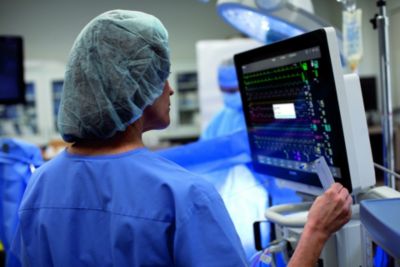
6 ways standardizing patient monitoring helps teams manage networks and assets
- By Philips
- August 12 2025
- 4 min read
For too long, health systems have added or replaced patient monitoring in a compromised way: Letting individual care units decide what to buy and put on the network. As a result, server environments have grown unwieldy, preferred technical specs have not always been met and disparate platforms have failed to work together. IT and biomedical teams have then struggled to address evolving needs with solutions that are streamlined, secure and stable. One answer? No longer installing unit by unit, or even hospital by hospital, but instead standardizing across the entire integrated delivery network.
At-a-glance:
- The legacy approach to patient monitoring – installing hospital by hospital and even unit by unit – has left a patchwork of platforms that poses difficulties for managing networks and assets.
- Unified and centralized patient monitoring, in contrast, can keep clinical needs paramount while applying enterprise-wide technical and security standards.
- Creating a cohesive, streamlined and secure solution across the integrated delivery network empowers IT and biomedical teams to drive performance, repel threats and promote continued innovation.

Performance needs and growing cybersecurity threats call for a new patient monitoring approach
As system consolidation and technological transformation continue across healthcare, IT and biomed teams face growing pressures with patient monitoring – not only to maintain equipment and network performance, but to also guard against growing dangers to data privacy and security.
A patchwork approach to monitoring often hinders those efforts. Purchased monitors may not have been designed to integrate seamlessly. Local servers can proliferate as systems get installed piecemeal, adding to complexity, possible instability and potential vulnerabilities. Confusion may even arise over what devices are on the network, how they’re managed and how they communicate.
Despite their best efforts, technical teams may struggle to find the time and other resources to constantly manage the jumble of vendors, monitors and software (often including variations in revision levels from the same vendor). It can become a never-ending task, one that can introduce variability and affect monitoring uptime and security.
An IDN-wide approach for patient monitoring takes a different approach, starting with planning and implementation. While clinical requirements remain paramount, system-wide technical and security standards get applied when assessing options. The goal is a simpler and more cohesive system that not only repels threats but promotes continued innovation.
A standardized and centralized solution can:
1. Promote integration and interoperability
The presence of disparate monitoring platforms means technical teams must wrangle a wider range of protocols, interfaces and data formats. This variety poses challenges for integrating with other information systems such as ADT and the EMR and keeping those connections stable, particularly when firmware and software get updated.
A single monitoring solution helps ease that complexity, supporting the consistent and flexible data access that clinical teams depend on. By promoting systems integration, it can also help reduce manual information entry on the floor, a workaround that can introduce errors.
A further opportunity comes from the interoperability some solutions offer, with the ability to pull in data from other medical devices connected to patients.
2. Streamline operations
By unifying their patient monitoring architecture, health systems can leave a smaller technical footprint to build and manage, including potentially fewer servers (and server licenses), data closets and, at times, domains. Standardized communication protocols and device interfaces may also reduce the number of gateways required.
This streamlining results in fewer points of potential failure and can help ease administrative and maintenance burdens. With servers, centralization also enables a more updated solution, through virtualization.
3. Centralize network administration and maintenance
A unified solution means technical teams can focus on managing a single, comprehensive system, rather than attempting to oversee multiple siloed platforms.
By gaining unified visibility across the enterprise, teams can track network health and potentially respond more quickly and effectively when interruptions occur. They can create maintenance programs, including schedules for planned downtime when system updates are needed. And they can follow standard workflows while promoting consistent staff training.
Centralization also enables the use of enterprise-wide tools that can help monitor the network and its assets, support troubleshooting, and identify opportunities for improvement.
4. Reinforce network security
IT teams may find it difficult to secure their monitoring ecosystems when they can’t fully design and manage them. Taking an enterprise-wide approach, on the other hand, can help health systems protect valuable, sensitive data, identify and address vulnerabilities, and proactively respond to threats.
The potential reduction in domains and servers with centralization can make it easier to keep network components secure and updated, with fewer access points and places for cyber-threats to hide. (If problems do occur, centralized systems are easier to back up and recover.)
Possible security benefits of monitoring unification include:
- Creation and implementation of an auditable security policy
- Greater visibility into data access and use, including through system-wide audit trails
- Streamlined patching of operating systems and applications and deployment of anti-virus and anti-malware programs
- Centralized management of certificates for device encryption
- Application of more modern security solutions, including firewalls and network segmentation (teams can look at traffic to determine which devices need to communicate together)
5. Simplify fleet management
With the number of monitor types reduced through standardization and remaining devices using the same technical platform, testing and maintenance become more streamlined for biomed teams. A common solution means that monitors have spare parts in common, supporting repairs. It may also provide an opportunity to reduce the variety of cables and other supplies required.
When it comes to training care teams, a standard monitor interface and common workflows can make the job easier. Some monitoring solutions also provide a platform for centralized asset management, to quickly view device information, troubleshoot problems, gauge utilization, and plan around inventory and capacity.
6. Provide flexibility and scalability
The shared infrastructure of a standardized and connected solution provides the ability to more easily add monitors to an existing care site or even incorporate a new location onto the platform – scalability not possible with fragmented systems. Since additional components follow the same data standards and protocols, a new Interoperability Standards Advisory is likely not required.
A single deployment can also allow health systems to flex their equipment to meet sudden spikes in demand, with monitors shareable across beds on the same domain. And it can help health systems more easily adopt new technologies or care models to stay at the forefront of innovation.
Copy this URLto share this story with your professional network
Sign up for news and updates

Disclaimer
Results are specific to the institution where they were obtained and may not reflect the results achievable at other institutions. Results in other cases may vary.